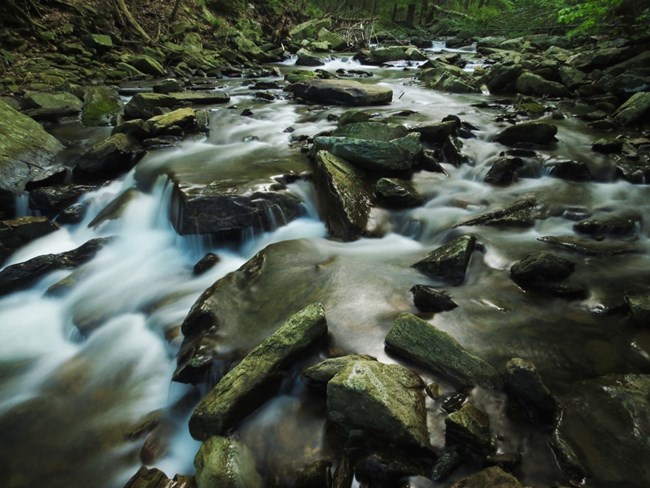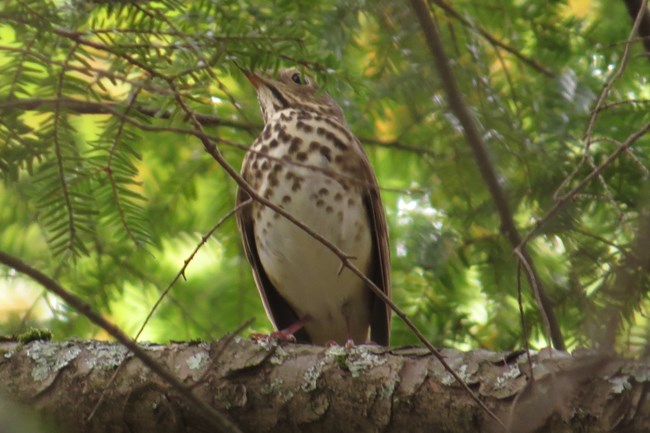How Does Climate Change Affect Animals And Plants
Commodity
Wildlife and Climatic change

NPS Photo / Graphic past 4C
Climate change has produced a number of threats to wildlife throughout our parks. Ascension temperatures lower many species survival rates due to changes that pb to less food, less successful reproduction, and interfering with the surround for native wild fauna. These detrimental changes are already apparent in our National Capital Area parks.
Ascension Temperatures and Invasive Species
Rising temperatures take chances destabilizing the residue between wild animals and their ecosystem. Equally plants adapt to changing warming patterns, usually by blooming earlier or shifting to cooler locations, the wildlife that has adapted to them volition exist forced to face new environments.
Some species will struggle to discover nutritious enough food to fit their existing gut biomes. Pollinators, for case, must feed from flowers that are blooming before in the year. Other animals may find their habitats are no longer able to support their biology.
Notwithstanding, it is also possible that some animals will do better in a warmer climate. Those species will outcompete others, expanding their own territory and food sources. Just not all wild fauna belong where they flourish. When species adapted to their environments lose their natural advantages, that leaves room for invasive species to multiply in the irresolute surroundings. Emerald Ash Borers and Gypsy Moths are examples of invasive species commonly found in the National Capital Region that have devastated native communities.

Photo by Kent Walters
Native Brook Trout at Risk
Brook trout in the Catoctin Mountain Park offer a clear example of how climate change effects interact with invasive species spread. The brook trout is a freshwater fish species native to eastern North America, and it requires cold, clear stream habitats. Competing with the beck trout are nonnative brown trout which can tolerate college temperatures.
Increases in air temperature are warming aquatic habitats, leading to an overall decrease in brook trout and giving the survival advantage to the invasive brown trout. A 2017 study from the US Geological Survey found that brook trout are capable of adapting and foraging for nutrient in warmer waters only non when they're competing confronting brown trout.
Flooding and Loss of Habitats
Increased atmospheric precipitation from climate change is contributing to more than frequent and extreme weather events such every bit flooding. The higher frequency of flooding has detrimental furnishings on wildlife because they tin destroy key pieces of ecosystems and habitats.
In that location is the obvious destructive upshot that floods have on the environment—such as flooded land and burned forests—simply they likewise have other lasting effects like severe water pollution. Speedy alluvion waters spend footling time in a purification identify (like in the ground or in a wetland) so the surface menses doesn't lose the soil particulates pollutants it has picked up. Their speed also erodes streambanks and soil surface. New locations of continuing water tin drown tree roots, too.

NPS Photo
Woods Thrush Migration
The wood thrush is the official bird of Washington, DC, and can exist establish in Rock Creek Park, but changes in climate may eliminate their regional population within the century. In addition to altering this songbird's DC habitat and nutrient sources, climatic change negatively interferes with the wood thrush's lengthy migration from Key America.
Forest thrushes fly up from the tropical forests of Central America every summer to their northern breeding grounds, anywhere from Florida to Maine. They need undecayed ripe fruit and insect populations to fuel their journey, which may not be available as the climate warms. Furthermore, their usual convenance grounds are growing warmer, pregnant they lose habitable areas and must fly farther north.

NPS Photo / Graphic by 4C
Last updated: December 8, 2021
Source: https://www.nps.gov/articles/000/wildlife-climateimpact.htm
Posted by: merrymanblene1972.blogspot.com

0 Response to "How Does Climate Change Affect Animals And Plants"
Post a Comment